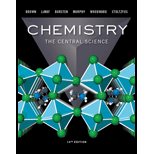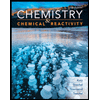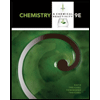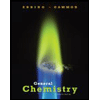
Study Guide for Chemistry: The Central Science
14th Edition
ISBN: 9780134554075
Author: Theodore E. Brown, H. Eugene LeMay, Bruce E. Bursten, Catherine Murphy, Patrick Woodward, Matthew E. Stoltzfus, James C. Hill
Publisher: PEARSON
expand_more
expand_more
format_list_bulleted
Textbook Question
Chapter 17, Problem 24E
A buffer is prepared by adding 10.0 g of ammonium chloride (NH4CI) to 250 mL of 1.00 M NH3 solution.
- What is the pH of this buffer?
- Write the complete ionic equation for the reaction that occurs when a few drops of nitric acid are added to the buffer.
- Write the complete ionic equation for the reaction that occurs when a few drops of potassium hydroxide solution are added to the buffer.
Expert Solution & Answer
Learn your wayIncludes step-by-step video

schedule06:26
Students have asked these similar questions
Writing the rate law implied by a simple mechanism
Suppose the formation of dinitrogen pentoxide proceeds by the following mechanism:
step
elementary reaction
-
1 NO2(g) + O2(g) → NO(g) + O2(g)
2
NO3(g) + NO2(g) →
N₂O(g)
rate constant
k₁
k₂
Suppose also k₁ «k2. That is, the first step is much slower than the second.
Write the balanced
chemical equation for the
overall chemical reaction:
Write the experimentally-
observable rate law for the
overall chemical reaction.
Note: your answer should
not contain the
concentrations of any
intermediates.
☐
rate =
☐
Express the rate constant
k for the overall chemical
reaction in terms of K1, K2,
and (if necessary) the rate
constants k-1 and K-2 for
the reverse of the two
elementary reactions in
the mechanism.
k =
☐
Х
5
olo
18
Ar
pls help asap on all.
pls help asap on all.
Chapter 17 Solutions
Study Guide for Chemistry: The Central Science
Ch. 17.1 - For the generic equilibrium HA(aq)H+(aq)+A(aq) ,...Ch. 17.1 - Practice Exercise 2 Calculate the pH of a solution...Ch. 17.1 - Calculate the concentration of the lactate ion in...Ch. 17.1 - Practice Exercise 2 Calculate the format ion...Ch. 17.2 - Practice Exercise 1 If the pH of a buffer solution...Ch. 17.2 - Prob. 17.3.2PECh. 17.2 - Prob. 17.4.1PECh. 17.2 - Prob. 17.4.2PECh. 17.2 - Calculate the number of grams of ammonium chloride...Ch. 17.2 - Prob. 17.5.2PE
Ch. 17.2 - Prob. 17.6.1PECh. 17.2 - Determine The pH of the original buffer described...Ch. 17.3 - An acid-base titration is performed: 250.0 mL of...Ch. 17.3 - Prob. 17.7.2PECh. 17.3 - Prob. 17.8.1PECh. 17.3 - Calculate the pH in the solution formed by adding...Ch. 17.3 - Prob. 17.9.1PECh. 17.3 - Prob. 17.9.2PECh. 17.4 - Which of these expressions correctly expresses the...Ch. 17.4 - Prob. 17.10.2PECh. 17.4 - You add 10.0 grams of solid copper(II) phosphate,...Ch. 17.4 - Prob. 17.11.2PECh. 17.4 - Prob. 17.12.1PECh. 17.4 - Prob. 17.12.2PECh. 17.5 - Consider a saturated solution of the salt MA3, in...Ch. 17.5 - Prob. 17.13.2PECh. 17.5 - Prob. 17.14.1PECh. 17.5 - Prob. 17.14.2PECh. 17.5 - Prob. 17.15.1PECh. 17.5 - Prob. 17.15.2PECh. 17.6 - An insoluble salt MA has a Kap of 1.0 × 10-10. Two...Ch. 17.6 - Does a precipitate form when 0.050 L of 2.0 × 10-2...Ch. 17.6 - Under what conditions does an ionic compound...Ch. 17.6 - Prob. 17.17.2PECh. 17 - Prob. 1DECh. 17 - The following boxes represent aqueos solutions...Ch. 17 - Prob. 2ECh. 17 - Prob. 3ECh. 17 - Prob. 4ECh. 17 - Prob. 5ECh. 17 - Prob. 6ECh. 17 - Prob. 7ECh. 17 - Prob. 8ECh. 17 - 17.9 The following graphs represent the behavior...Ch. 17 - Prob. 10ECh. 17 - 17.11 The graph below shows the solubility of a...Ch. 17 - 17.12 Three cations, Ni+2, Cu+2, and Ag+, are...Ch. 17 - Prob. 13ECh. 17 - Prob. 14ECh. 17 - Prob. 15ECh. 17 - Use information from Appendix D to calculate the...Ch. 17 - Prob. 17ECh. 17 - a. calculate the percent ionization of 0.125 M...Ch. 17 - Prob. 19ECh. 17 - 17.20 Which of the following solutions is a...Ch. 17 - Prob. 21ECh. 17 - Calculate the pH of a buffer that is 0.105n M in...Ch. 17 - Prob. 23ECh. 17 - A buffer is prepared by adding 10.0 g of ammonium...Ch. 17 - You are asked to prepare a pH = 3.00 buffer...Ch. 17 - You are asked to prepare an pH = 4.00 buffer...Ch. 17 - Prob. 27ECh. 17 - Prob. 28ECh. 17 - Prob. 29ECh. 17 - Prob. 30ECh. 17 - Prob. 31ECh. 17 - Prob. 32ECh. 17 - The accompanying graph shows the titration curves...Ch. 17 - Prob. 34ECh. 17 - 17.35 The samples of nitric and acetic acids shows...Ch. 17 - 17.36 Determine whether each of the following...Ch. 17 - Prob. 37ECh. 17 - Prob. 38ECh. 17 - Prob. 39ECh. 17 - Assume that 30.0 mL of a M solution of a week base...Ch. 17 - Prob. 41ECh. 17 - Prob. 42ECh. 17 - Prob. 43ECh. 17 - Prob. 44ECh. 17 - Prob. 45ECh. 17 - Consider the titration of 30.0 mL of 0.050 M NH3...Ch. 17 - Prob. 47ECh. 17 - Prob. 48ECh. 17 - 17.49 for each statement, incate whether it is...Ch. 17 - The solubility of two slighty soluble salts of...Ch. 17 - Prob. 51ECh. 17 - 17.52
a. true or false: solubility and...Ch. 17 - If the molar solubility CaF2 at 35 C is 1.24 *10-3...Ch. 17 - Prob. 54ECh. 17 - Prob. 55ECh. 17 - Prob. 56ECh. 17 - using calculate the molar solubility of AgBr in a....Ch. 17 - calculate the solubility of LaF3 in grams per...Ch. 17 - Prob. 59ECh. 17 - Consider a beaker containing a saturated solution...Ch. 17 - Calculate the solubility of Mn (OH) 2 in grams per...Ch. 17 - Calculate the molar solubility of Ni (OH) 2 when...Ch. 17 - 17.63 Which of the following salts will be...Ch. 17 - For each of the following slightly soluble salts,...Ch. 17 - Prob. 65ECh. 17 - Prob. 66ECh. 17 - Use values of Kap for Agl and Kf for Ag (CN) 2- to...Ch. 17 - Prob. 68ECh. 17 - Prob. 69ECh. 17 - Prob. 70ECh. 17 - Calculate the minimum pH needed to precipitate Mn...Ch. 17 - Prob. 72ECh. 17 - Prob. 73ECh. 17 - Prob. 74ECh. 17 - Prob. 75ECh. 17 - Prob. 76ECh. 17 - A solution containing several metal ions is...Ch. 17 - An unknown solid is entirely soluble in water. On...Ch. 17 - Prob. 79ECh. 17 - Prob. 80ECh. 17 - 17.81
Precipitation of the group 4 cautions of...Ch. 17 - Prob. 82ECh. 17 - Prob. 83AECh. 17 - Prob. 84AECh. 17 - Furoic acid (HC5H3O3) has a K value of 6.76 x 10-4...Ch. 17 - Prob. 86AECh. 17 - Equal quantities of 0.010 M solution of an acid HA...Ch. 17 - Prob. 88AECh. 17 - 17.89 A biochemist needs 750 ml of an acetic...Ch. 17 - A sample of 0.2140 g of an unknown monophonic acid...Ch. 17 - A sample of 0.1687 g of an unknown monoprotic acid...Ch. 17 - Prob. 92AECh. 17 - Prob. 93AECh. 17 - What is the pH of a solution made by mixing 0.30...Ch. 17 - Suppose you want to do a physiological experiment...Ch. 17 - Prob. 96AECh. 17 - Prob. 97AECh. 17 - For each pair of compounds, use Kap values to...Ch. 17 - Prob. 99AECh. 17 - Tooth enamel is composed of hydroxyapatite, whose...Ch. 17 - Salts containing the phosphate ion are added to...Ch. 17 - Prob. 102AECh. 17 - 17.103 The solubility –product constant for barium...Ch. 17 - Prob. 104AECh. 17 - Prob. 105AECh. 17 - A buffer of what pH is needed to give a Mg2+...Ch. 17 - The value of Kap for Mg3(AsO4)2 is 2.1 10-20 ....Ch. 17 - Prob. 108AECh. 17 - Prob. 109AECh. 17 - Prob. 110IECh. 17 - Prob. 111IECh. 17 - Prob. 112IECh. 17 - Prob. 113IECh. 17 - Prob. 114IECh. 17 - Prob. 115IECh. 17 - Prob. 116IECh. 17 - A concentration of 10-100 parts per billion (by...Ch. 17 - Prob. 118IECh. 17 - Prob. 119IECh. 17 - In nonaqueous solvents, it is possible to react HF...
Additional Science Textbook Solutions
Find more solutions based on key concepts
Albinism in humans is inherited as a simple recessive trait. For the following families, determine the genotype...
Concepts of Genetics (12th Edition)
Law of conservation of massand how it relates to the copper cycle haveto be explained. Concept introduction: So...
Living By Chemistry: First Edition Textbook
Modified True/False 6. __________ Halophiles inhabit extremely saline habitats, such as the Great Salt Lake.
Microbiology with Diseases by Body System (5th Edition)
Identify each of the following reproductive barriers as prezygotic or postzygotic. a. One lilac species lives o...
Campbell Essential Biology with Physiology (5th Edition)
Fibrous connective tissue consists of ground substance and fibers that provide strength, support, and flexibili...
Human Biology: Concepts and Current Issues (8th Edition)
What are four functions of connective tissue?
Anatomy & Physiology (6th Edition)
Knowledge Booster
Learn more about
Need a deep-dive on the concept behind this application? Look no further. Learn more about this topic, chemistry and related others by exploring similar questions and additional content below.Similar questions
- pls help asap on all.arrow_forward18. A 10.2g piece of coal (carbon) is combusted completely beneath a calorimeter containing 800.0 mL of water. The initial temp of the water was 20.0°C, and the final temp was 62.7°C. Assuming complete transfer of heat from the carbon to the water, what is the molar enthalpy of combustion of carbon?arrow_forwardpls help asap on all.arrow_forward
- pls help asap on all.arrow_forwardUse the reaction coordinate graph below to answer questions 13-15: 13. Which step is the rate determining step? a. C→ E b. E→ G C. A → C d. Not enough information 14. The overall reaction: a. is exothermic b. is endothermic C. has no change in energy Energy d. not enough information 15. The activation energy for the overall reaction would be equal to: a. Ꭰ A b. F C. B d. B + D + F B 0 D E Reaction coordinate Garrow_forwardpls help asap on all.arrow_forward
- pls help asap on all.arrow_forward3. Which of the following best describes the changes in reaction rate for the reactants as a reaction progresses? a. Reaction rate remains relatively constant for the duration of the reaction b. Reaction rate is highest at the beginning, and decreases over time C. Reaction rate is highest at the beginning and end of a reaction d. Reaction rate is slow at first, then increases 4. Which of these would be the closest to being an isolated system? a. A well-insulated steel thermos b. Earth C. A sealed plastic container d. All of the above are examples 5. A chemical engineer is performing a test to see if a proposed catalyst for an industrial chemical reaction is working effectively. Which of the following would be positive evidence that it's working? a. The enthalpy of the reaction increases b. Less heat is required to get the reaction started C. The reaction creates new products d. The enthalpy of the reaction decreasesarrow_forwardPls help me on this q.arrow_forward
- Given the elementary reactions in an aqueous medium with an ionic strength of 0.001:1) CH3Br + OH- → CH3OH + Br-2) ClCH2COO- + OH- → HOCH2COO- + Cl-3) [Co(NH3)5Br]2+ + NO2- →[Co(NH3)5NO2]2+ + Br-If the ionic strength is decreased, 1) k will not change; 2) k will decrease; and 3) k will increase. Is this correct?arrow_forwardRelate zero ionic strength and infinite dilution limit.arrow_forwardThe photolysis of H3C–N=N–C2H5 involves the breaking of the single bonds shown. According to this, in addition to N2, what products would be obtained primarily if the reaction were carried out in the gas phase or in solution in an inert solvent?arrow_forward
arrow_back_ios
SEE MORE QUESTIONS
arrow_forward_ios
Recommended textbooks for you
 Chemistry: The Molecular ScienceChemistryISBN:9781285199047Author:John W. Moore, Conrad L. StanitskiPublisher:Cengage Learning
Chemistry: The Molecular ScienceChemistryISBN:9781285199047Author:John W. Moore, Conrad L. StanitskiPublisher:Cengage Learning General, Organic, and Biological ChemistryChemistryISBN:9781285853918Author:H. Stephen StokerPublisher:Cengage Learning
General, Organic, and Biological ChemistryChemistryISBN:9781285853918Author:H. Stephen StokerPublisher:Cengage Learning Chemistry & Chemical ReactivityChemistryISBN:9781337399074Author:John C. Kotz, Paul M. Treichel, John Townsend, David TreichelPublisher:Cengage Learning
Chemistry & Chemical ReactivityChemistryISBN:9781337399074Author:John C. Kotz, Paul M. Treichel, John Townsend, David TreichelPublisher:Cengage Learning Chemistry & Chemical ReactivityChemistryISBN:9781133949640Author:John C. Kotz, Paul M. Treichel, John Townsend, David TreichelPublisher:Cengage Learning
Chemistry & Chemical ReactivityChemistryISBN:9781133949640Author:John C. Kotz, Paul M. Treichel, John Townsend, David TreichelPublisher:Cengage Learning Chemistry: Principles and ReactionsChemistryISBN:9781305079373Author:William L. Masterton, Cecile N. HurleyPublisher:Cengage Learning
Chemistry: Principles and ReactionsChemistryISBN:9781305079373Author:William L. Masterton, Cecile N. HurleyPublisher:Cengage Learning General Chemistry - Standalone book (MindTap Cour...ChemistryISBN:9781305580343Author:Steven D. Gammon, Ebbing, Darrell Ebbing, Steven D., Darrell; Gammon, Darrell Ebbing; Steven D. Gammon, Darrell D.; Gammon, Ebbing; Steven D. Gammon; DarrellPublisher:Cengage Learning
General Chemistry - Standalone book (MindTap Cour...ChemistryISBN:9781305580343Author:Steven D. Gammon, Ebbing, Darrell Ebbing, Steven D., Darrell; Gammon, Darrell Ebbing; Steven D. Gammon, Darrell D.; Gammon, Ebbing; Steven D. Gammon; DarrellPublisher:Cengage Learning

Chemistry: The Molecular Science
Chemistry
ISBN:9781285199047
Author:John W. Moore, Conrad L. Stanitski
Publisher:Cengage Learning

General, Organic, and Biological Chemistry
Chemistry
ISBN:9781285853918
Author:H. Stephen Stoker
Publisher:Cengage Learning

Chemistry & Chemical Reactivity
Chemistry
ISBN:9781337399074
Author:John C. Kotz, Paul M. Treichel, John Townsend, David Treichel
Publisher:Cengage Learning

Chemistry & Chemical Reactivity
Chemistry
ISBN:9781133949640
Author:John C. Kotz, Paul M. Treichel, John Townsend, David Treichel
Publisher:Cengage Learning

Chemistry: Principles and Reactions
Chemistry
ISBN:9781305079373
Author:William L. Masterton, Cecile N. Hurley
Publisher:Cengage Learning

General Chemistry - Standalone book (MindTap Cour...
Chemistry
ISBN:9781305580343
Author:Steven D. Gammon, Ebbing, Darrell Ebbing, Steven D., Darrell; Gammon, Darrell Ebbing; Steven D. Gammon, Darrell D.; Gammon, Ebbing; Steven D. Gammon; Darrell
Publisher:Cengage Learning
Ocean Chemistry; Author: Beverly Owens;https://www.youtube.com/watch?v=IDQzklIr57Q;License: Standard YouTube License, CC-BY